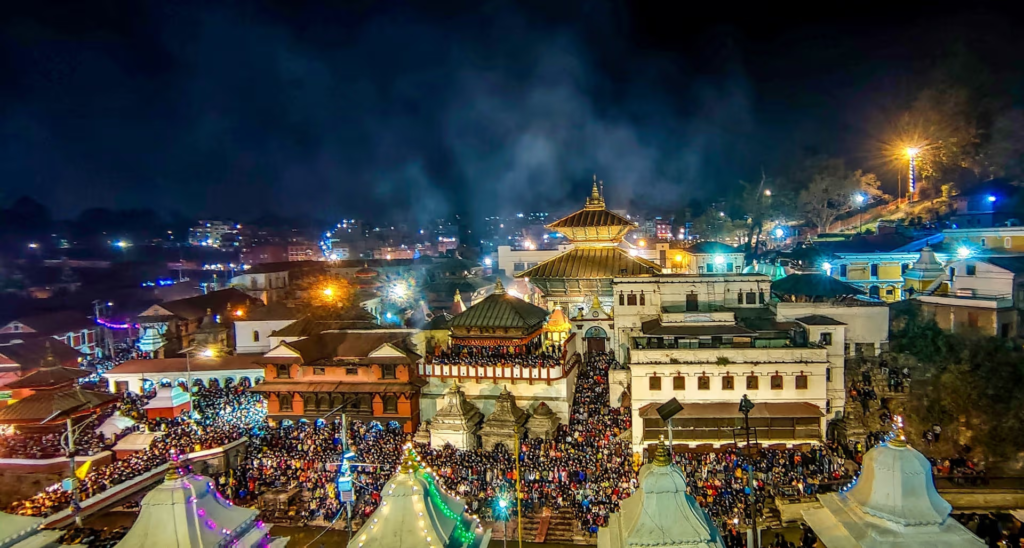
📚 Table of Contents
- Introduction: The Night That Transcends Time
- The Spiritual Essence of Maha Shivaratri
- Legends That Light Up the Night
- Why Do We Stay Awake? The Power of Jagaran
- Rituals That Connect the Soul to Shiva
- Fasting with Faith: A Cleansing of Mind and Body
- Symbolism: Beyond Milk and Bael Leaves
- Modern Reflections: Maha Shivaratri in Today’s World
- Final Thoughts: A Night to Transform, Not Just Celebrate
1. Introduction: The Night That Transcends Time
Maha Shivaratri, or “The Great Night of Shiva,” is more than a festival—it’s an experience. It’s a sacred pause in the cosmic rhythm, a night where time seems to stand still and the soul seeks something beyond the material world. Celebrated on the 14th night of the waning moon in the Hindu month of Phalguna (February–March), this night is devoted entirely to Lord Shiva, the god of destruction, transformation, and transcendence.
2. The Spiritual Essence of Maha Shivaratri
This isn’t a night of loud celebrations or fireworks—this is a night of stillness. A night where millions meditate, chant, fast, and offer prayers with deep reverence. It’s believed that the cosmic energy of this night aligns perfectly with the human system, making spiritual practices many times more powerful.
3. Legends That Light Up the Night
Maha Shivaratri is surrounded by captivating stories:
- The Divine Union: It marks the wedding of Lord Shiva and Goddess Parvati.
- The Neelkanth Legend: The night Shiva consumed the deadly poison during the Samudra Manthan to save the universe.
- The Night of Cosmic Dance: It’s believed Shiva performs his Tandava—the dance of creation and destruction—on this night.
Each tale adds a layer of meaning to this divine celebration.
4. Why Do We Stay Awake? The Power of Jagaran
Devotees stay awake all night, participating in Jagaran (night-long vigil), chanting Shiva’s name, and immersing themselves in bhajans and meditation. This wakefulness symbolizes heightened consciousness—staying alert not just physically, but spiritually.
5. Rituals That Connect the Soul to Shiva
- Abhishekam (ceremonial bathing of the Shiva Linga) with water, milk, honey, curd, and ghee.
- Offering Bael leaves, which are believed to calm the fiery energy of Shiva.
- Chanting the Maha Mrityunjaya Mantra or “Om Namah Shivaya” continuously.
These are not just rituals—they are methods to cleanse and uplift the spirit.
6. Fasting with Faith: A Cleansing of Mind and Body
Devotees observe strict fasts—some go without food or water, while others consume only fruits or milk. This fasting isn’t about denial, but discipline. It is said to purify the body and bring clarity to the mind, preparing it for deeper spiritual connection.
7. Symbolism: Beyond Milk and Bael Leaves
Every offering made to Shiva holds symbolic significance:
- Milk: Purity and devotion
- Honey: Sweetness of inner realization
- Bael leaves: Trifoliate symbolizing the three eyes of Shiva and the three gunas (sattva, rajas, tamas)
- Ash (Vibhuti): Renunciation and the impermanence of life
These elements come together to remind us of the core values of simplicity, surrender, and self-realization.
8. Modern Reflections: Maha Shivaratri in Today’s World
In our fast-paced, tech-driven lives, Maha Shivaratri offers a chance to slow down. Temples may be decorated, and live streams of pujas abound online—but the true celebration still lies in silent self-reflection, letting go of ego, and awakening the divine within.
Even youngsters now embrace this night as a spiritual detox from worldly noise.
9. Final Thoughts: A Night to Transform, Not Just Celebrate
Maha Shivaratri is not just about rituals—it’s about transformation. It invites us to destroy inner darkness, ignorance, and pride—just as Shiva does with his third eye.
So this Shivaratri, don’t just light a lamp—ignite the light within.
“Shivoham” – I am Shiva, I am pure consciousness.

